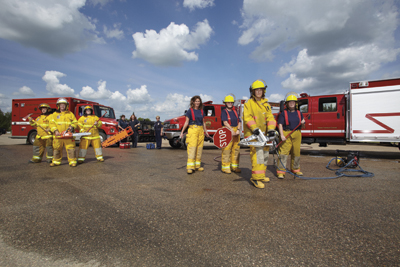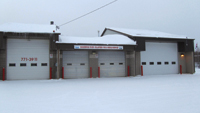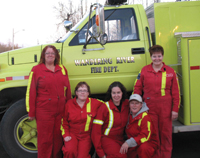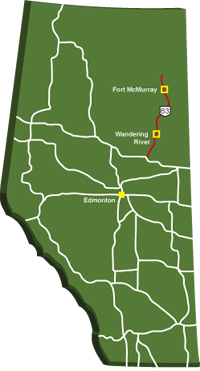
Features
Volunteers
Facing facts
The 120-page report on firefighter recruitment and retention in Alberta begins like this: The issue of recruiting and retaining firefighters is a worldwide issue that we in the Alberta fire service were naive enough to believe wasn’t affecting us.
February 8, 2011
By
Laura King
The 120-page report on firefighter recruitment and retention in Alberta begins like this: The issue of recruiting and retaining firefighters is a worldwide issue that we in the Alberta fire service were naive enough to believe wasn’t affecting us.
The report was released in May at the Alberta Fire Chiefs Association (AFCA) conference, about a month before the seven female members of the Wandering River Fire & Rescue Service in northern Alberta quit because they couldn’t keep up with the demand for their firefighting, medical and extrication services on Highway 63.
During our 2008 annual conference, our membership debated a resolution on recruitment and retention and it became evident we did have issues. It was time to stop hiding our heads in the sand and look at who and what we are when it comes to recruiting new members and keeping the old.
 |
| Firefighters from Grasslands (left) and Wandering River, Alta., pose for a photo for a fundraising calendar. Grasslands had responded to Wandering River’s calls but has stopped doing so due to the demand and the dangers on Highway 63. Wandering River shut down because its volunteers couldn’t meet the demand for service. Photo by The Fire Within |
 |
|
| Photo by Maureen Hagan Advertisement
|
And so, in late 2008, the AFCA and the Alberta Emergency Management Agency delved deeply into a crisis that is strangling volunteer and composite fire departments across Canada.
The report – and its so-called tool kit for fire chiefs – is a groundbreaking document, a model for other provinces and a think-outside-the-box package that its authors hope will restore departments like Wandering River and prevent others from similar fates.
Not all the tools are painted red and have lights and sirens but we, as innovative fire chiefs, will still see the value of the tools and we can paint it [the report] red if we need to make it work for our individual services.
The report includes 15 initiatives for fire departments to embrace, from involving current volunteer firefighters in planning formal recruitment drives to establishing child-care services and diversity policies. Each initiative comes with a series of tools and templates to provide consistency for fire chiefs and to make it easier for them to implement the recommended strategies.
Bonnyville Fire Chief Brian McEvoy was the president of the AFCA when the process began and he co-chaired the 16-member recruitment and retention working group. In perhaps the most significant outside-the-box move, the working group brought in experts on volunteering to help with the project, along with fire-service and emergency management leaders.
“Volunteer Alberta brought its expertise from working with all segments of the volunteer spectrum and were able to look at our organizations and operations without the red lights and sirens,” McEvoy said in an interview.
“They looked at us as a volunteer organization, and by looking at it that way they got a different view of it. They saw it for the raw components and they didn’t see it for the romanticized, fight-fires-save-lives type of thing.”
McEvoy admits that the relationship with Volunteer Alberta (www.volunteeralberta.ab.ca), a provincially funded, not-for-profit support agency, was tumultuous at first, but committee members worked hard to correct the misunderstandings.
“Volunteer fire fighting is probably the highest level of commitment in the volunteer world,” says McEvoy, who put things in perspective for the group by comparing members of community service groups to volunteer firefighters.
 |
|
| The all-female crew of the Wandering River Fire Department: Deputy Chief Maureen Hagan (left), firefighters Jennifer Batiuk and Carolyn Brucker, Acting Chief Sheri Johnson and firefighter Janet Smydmiller. Photo courtesy Sheri Johnson |
“The comment I made was the primary difference between The Kinsmen Club and a fire department staffed by volunteers is that if there aren’t enough people to hold a meeting on a Tuesday then you reschedule the meeting but you can’t reschedule a fire.
“That was a key learning component on their side that we had to get over and once we got over that, then we could look at this issue in as broad a spectrum as possible. Once they got that, they looked at the type of people we were attracting and how we could attract them.”
At first, fire chiefs in the seven AFCA regions to which members of the working group travelled to gather information were reluctant to admit there were problems with recruitment and retention. But later, as word spread about the committee, and chiefs started comparing notes and understanding the group’s objectives, the magnitude of the problem became clear.
Additionally, the committee learned that problems and solutions discussed at the original fact-finding meetings spread from chief to chief, and by the time the group got further into the process, departments in some communities had started implementing strategies discussed around the table at earlier meetings in other communities.
“In some cases, we would sit there and everybody would say, ‘We don’t have a problem,’ until they started talking, then all of the sudden they’re saying ‘Maybe we do.’ It became quite interesting as we went through it,” McEvoy said.
 |
|
| Recruitment and retention is a Canada-wide problem but it has been particularly evident in Alberta, where departments have closed or reduced service. Departments along the busy Highway 63 to Fort McMurray are particularly challenged. Graphic by Krista Misener |
For working group members, learning and accepting that the Alberta fire service is indeed mired in a recruitment and retention crisis was the first part of the project; the second part was the development of strategies for recruitment and retention of volunteer firefighters and the creation of the tool kit to help chiefs find and keep good people in their departments. This is primarily where Volunteer Alberta’s expertise prevailed.
As McEvoy explained, many volunteer groups have screening processes for their members and those members work toward goals – fundraising, community spirit or building a playground for children, for example. Setting goals promotes co-operation, drive and morale, and achieving goals results in satisfaction and pride.
“If there’s a goal and purpose they can work toward then everything’s good,” McEvoy says of firefighters. “You don’t see problems on the fire ground because everyone has a common goal. But you have problems in the fire hall.”
The solution is to provide added value for volunteer firefighters so that they see a purpose for giving up their family time and free time to train; defining and claiming that communal purpose makes volunteer firefighters want to give back to their communities.
“People look for a focus and they want a focus,” McEvoy says. “If you give it to them, things run smoothly.”
But that’s easier said than done. In many cases, says McEvoy, volunteer fire chiefs are good at putting out fires or responding to collisions but don’t have the leadership or management skills that the job now demands.
“When we move people up, we give them the position but we don’t give
them the tools to do the job,” he said. “We have people who come up in
the fire service that are extremely good at the response component, but
that’s only about 10 per cent of the job. We’ve come a long way in
Alberta developing good officer training tools and if you take a look at
the departments that are thriving you will see that they have good
officer training skills – that’s not just fire training, it’s training
in the management components.”
Another issue, he said, is the disconnect between municipal administrations and their volunteer fire departments. McEvoy cites municipalities with populations of between 10,000 and 15,000 that operate volunteer fire departments but have never given their fire chiefs access to services such as human resources departments.
“When these municipalities do senior staff training, why are they not inviting the fire chief? The fire chief in a town of 8,000 to10,000 is a director or senior manager of that town. I see it all the time – these guys are not considered when the senior managers or CEOs look at doing management training for their staff.
“In one case, a town brought in a consultant to do conflict resolution training for all senior managers and the fire chief found out about it afterwards when talking to the planning director. There’s that disconnect.
“As a manager within a fire department – volunteer or composite – you’re caught between a rock and a hard place; the firefighters look at you as a senior manager and the rest of the municipal management looks at you as an annoyance.”
Chad Sartison, a volunteer firefighter and member of the working group, says the recruitment and retention report provides the first step toward a paradigm shift in the way the Canadian volunteer fire service works.
“The great conundrum surrounding this issue is that there are as many opinions on recruitment and retention as there are people talking about it. Although talk is good the Alberta study takes the talk one step further,” says Sartison, president of The Fire Within.
“This study represents government and the Alberta chiefs association coming together. It not only acknowledges the challenges facing chiefs but it arms them with hard data, not the anecdotal rhetoric that usually accompanies this discussion.
“Canada’s volunteer chiefs, however, are still on the sharp end of the spear and this study only represents a beginning. My fear is that the fire service and government has yet to undergo the tremendous contextual shift needed before studies like this can be put to good use and that ultimately will be up to the chiefs who read it.”
As for Wandering River, McEvoy expects the department will benefit from the report and the tool kit that provides those outside-the-box ideas, strategies and mechanisms to find and keep new volunteer firefighters.
“They will be able to take some things from it – the components in our tool box on community involvement and spousal support will help them to evolve their service,” he said.
“One of the things that will go a long way in addressing the [Wandering River] issue is better co-operation with surrounding services – getting together and looking at and developing an emergency response strategy on that Highway 63 corridor. But that requires a lot of inter-municipal co-operation and support from the provincial government and it will take some time.”
That’s exactly what Wandering River Acting Chief Sheri Johnson believes. In an interview in late January, two days before Athabasca County Council was expected to formally shut down the Wandering River department, Johnson said the municipality has to take a hard look at the role of its volunteer fire department.
“Part of this has to be put on the municipality to say we’re only willing to let our fire department go to our city limits,” Johnson said “We’ve never been told that we don’t have to go further than that. Mariana Lake is 102 kilometres north of us and that’s where [the regional] boundary stops, and we have gone further than that when we’ve been asked to.”
Johnson says she and the five remaining female volunteer firefighters (three of whom plan to resign whether or not the department closes) have done the best they can to fulfil their obligations but sending two people to an extrication call on a dangerous, busy highway is simply not safe.
Meanwhile, Johnson hopes the report is a wake up call that alerts municipalities to the fact that the volunteer firefighting system needs to incorporate more regional thinking.
“We are a small community so we don’t have a base to draw from. About 65 per cent of our community is 65 and older, so if we have 200 to 300 people, we’re drawing from 100 of those available to volunteer. The other factor is that a lot of the people in this community have stood up and said we don’t want to be on this highway [as volunteer firefighters].”
The report can be downloaded from the AFCA site at www.afca.ab.ca. Click on news, then scroll down to Recruitment and Retention Final Report, July 5, 2010.
On the Web: The Redwood Meadows Fire and Emergency Services has created a recruitment and retention model that works. Story and photos by Rob Evans.
Issues impacting recruitment and retention
-Recruitment & Retention, sub-committee report to the 2010 annual AFCA conference |
| R and R initiatives The report outlines several initiatives for struggling fire departments:
For |
Print this page